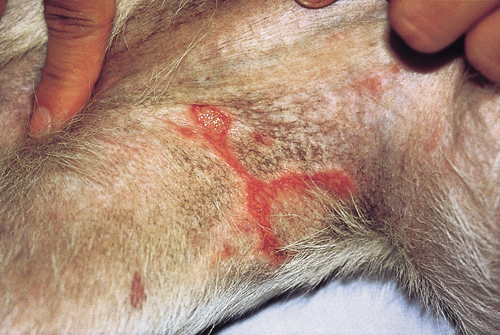Difference between revisions of "Small Animal Dermatology Q&A 06"
Ggaitskell (talk | contribs) (Created page with "{{Template:Manson Moriello}} centre|500px<br> <br /> '''The inguinal fold area of a partially paralyzed dog is shown. The dog was ...") |
|||
| Line 12: | Line 12: | ||
|a1= | |a1= | ||
The most likely cause is urine scalding. This is an irritant reaction caused by the skin being chronically wet from exposure to urine. | The most likely cause is urine scalding. This is an irritant reaction caused by the skin being chronically wet from exposure to urine. | ||
| − | |l1= | + | |l1=Contact Dermatitis |
|q2=How should this lesion be treated to prevent it from happening again? | |q2=How should this lesion be treated to prevent it from happening again? | ||
|a2= | |a2= | ||
| Line 20: | Line 20: | ||
Urine scald lesions are a risk factor in any animal that is recumbent and/or paralyzed. The owners need to express the dog’s bladder more efficiently and/or more frequently. If this dog is having urine scalding, it is very likely that the dog may also develop pressure point necrosis. <br><br> | Urine scald lesions are a risk factor in any animal that is recumbent and/or paralyzed. The owners need to express the dog’s bladder more efficiently and/or more frequently. If this dog is having urine scalding, it is very likely that the dog may also develop pressure point necrosis. <br><br> | ||
The dog should be turned more frequently and consideration should be given to putting the dog in a body sling until it recovers. | The dog should be turned more frequently and consideration should be given to putting the dog in a body sling until it recovers. | ||
| − | |l2= | + | |l2=Contact Dermatitis#Treatment |
|q3=What are the most common irritants encountered by small animals? | |q3=What are the most common irritants encountered by small animals? | ||
|a3= | |a3= | ||
Irritant reactions are most likely to occur on thinly haired areas. The most commonly incriminated irritants include soaps, detergents, disinfectants, weed and insecticidal sprays, flea collars, fertilizers, and carpet cleaners or fresheners. | Irritant reactions are most likely to occur on thinly haired areas. The most commonly incriminated irritants include soaps, detergents, disinfectants, weed and insecticidal sprays, flea collars, fertilizers, and carpet cleaners or fresheners. | ||
| − | |l3= | + | |l3=Contact Dermatitis |
</FlashCard> | </FlashCard> | ||
Latest revision as of 22:34, 31 August 2011
| This question was provided by Manson Publishing as part of the OVAL Project. See more small animal dermatological questions |
The inguinal fold area of a partially paralyzed dog is shown. The dog was expected to regain voluntary movement and was released to the owners for home care. The owners manually expressed the dog’s bladder six times per day; however, the dog was often found wet from urine leakage.
| Question | Answer | Article | |
| What is the most likely cause of the lesion shown? | The most likely cause is urine scalding. This is an irritant reaction caused by the skin being chronically wet from exposure to urine. |
Link to Article | |
| How should this lesion be treated to prevent it from happening again? |
Urine scald lesions are a risk factor in any animal that is recumbent and/or paralyzed. The owners need to express the dog’s bladder more efficiently and/or more frequently. If this dog is having urine scalding, it is very likely that the dog may also develop pressure point necrosis. |
Link to Article | |
| What are the most common irritants encountered by small animals? | Irritant reactions are most likely to occur on thinly haired areas. The most commonly incriminated irritants include soaps, detergents, disinfectants, weed and insecticidal sprays, flea collars, fertilizers, and carpet cleaners or fresheners. |
Link to Article | |
